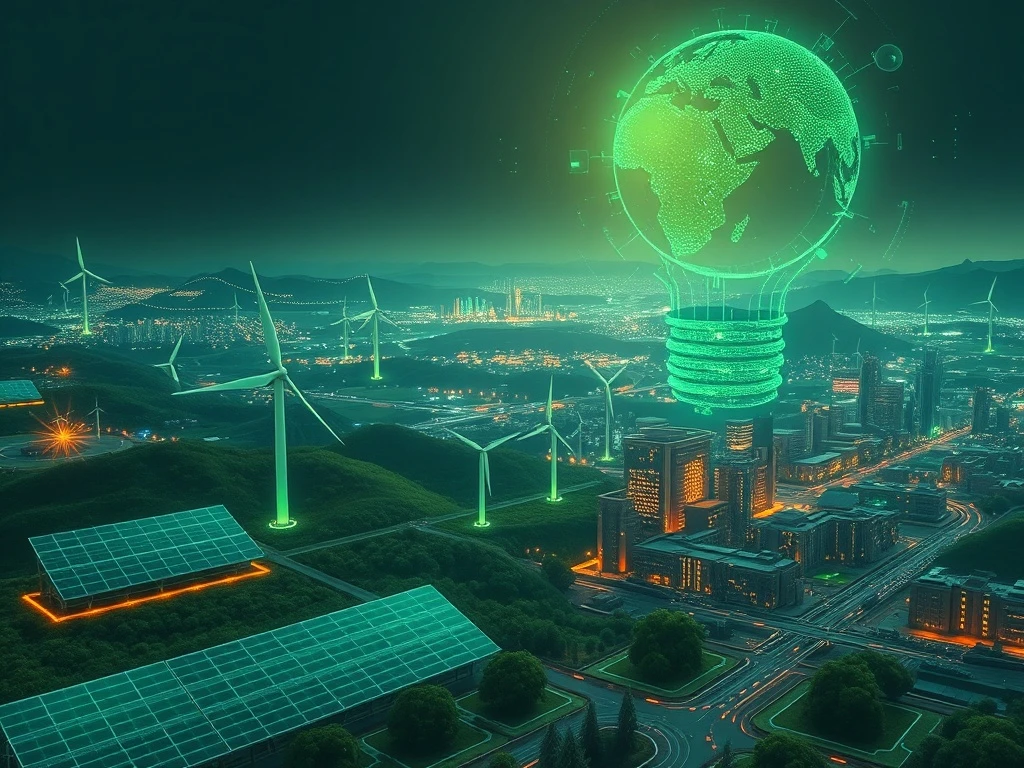Businesses worldwide face increasing pressure to address their environmental impact. From regulatory mandates to evolving customer expectations, sustainability has transformed from an option into a core strategic priority. Fortunately, **Climate Technology** now enables a swift transition to a low-carbon economy. It provides businesses with essential tools to measure and significantly reduce greenhouse gas emissions. Artificial intelligence (AI), big data analytics, and emerging green innovations drive this meaningful change. Furthermore, policy frameworks like the Carbon Border Adjustment Mechanism (CBAM) help regulate corporate behavior, accelerating the global transition. **Climate Technology** is truly shaping the future.
AI and Big Data: Revolutionizing Climate Technology Management
Artificial intelligence is revolutionizing how companies collect, analyze, and understand sustainability data. Smart algorithms and advanced predictive analytics allow organizations to track carbon usage in real time. They can also detect patterns that might otherwise remain hidden. This significantly improves the precision of emissions reporting. It helps identify activities and processes with the highest environmental impacts. Consequently, businesses gain clearer insights.
The combination of machine learning and large-scale datasets means businesses can predict consumption accurately. They can optimize industrial processes, ultimately reducing energy use. A growing number of manufacturers now rely on AI-enabled digital twins. These tools simulate potential improvements and assess environmental effects before real-world implementation. This type of analysis proves particularly useful in supply chain management. Much of a company’s carbon footprint often originates there. Therefore, AI offers a powerful solution.
AI can identify low-carbon suppliers effectively. It proposes alternative transportation routes. It even automates purchasing decisions that support sustainability objectives. Moreover, AI makes it possible to integrate weather patterns and climate risk into operational planning. Data-driven forecasts help industries anticipate resource availability. They also minimize waste generation. These advances are not only good for the planet; they also help companies remain agile and competitive in a fast-changing business landscape. **Climate Technology** powered by AI is a game-changer.
Advanced AI Applications in Climate Technology
Beyond basic tracking, AI offers deeper applications for environmental stewardship:
- Predictive Maintenance: AI analyzes equipment data to predict failures, reducing energy waste from inefficient machinery.
- Smart Agriculture: AI optimizes irrigation and fertilizer use, minimizing resource consumption and emissions in farming.
- Climate Modeling: Sophisticated AI models forecast climate impacts, helping businesses prepare for environmental risks.
- Carbon Accounting Platforms: AI automates data collection from diverse sources, streamlining complex carbon footprint calculations.
These applications demonstrate AI’s broad potential. They provide actionable insights for environmental improvements. Businesses can make data-driven decisions. This leads to more sustainable operations. Therefore, AI is central to modern **Climate Technology**.
Green Technologies: Pillars of Sustainable Climate Technology Operations
Alongside AI and advanced analytics, new green technologies are transforming how goods are produced, transported, and consumed. Renewable energy systems, smart grids, energy storage, and circular economy solutions are now integrated directly into industrial operations. These innovations form the backbone of modern **Climate Technology**.
Photovoltaic systems and on-site wind farms significantly reduce the need for fossil fuels. Smart grid solutions facilitate demand-response and energy sharing. In manufacturing, closed-loop systems help recycle waste products. They also reduce the use of raw materials. Carbon capture and storage (CCS) technologies are gaining traction. They are increasingly becoming part of long-term decarbonization strategies. These technologies represent critical steps towards a greener industrial future.
Companies across several sectors have implemented IoT-enabled sensors. These monitor resource consumption. They send real-time alerts when energy consumption spikes. Combined with automated control systems, this enables accurate emissions measurement on the production floor. It offers a pragmatic path toward carbon neutrality. These long-term improvements help businesses reduce operating costs. They also strengthen their sustainability commitments. Green technologies provide tangible benefits for both planet and profit.
Emerging Green Innovations in Climate Technology
The landscape of green technology is constantly evolving. New innovations promise even greater environmental impact:
- Green Hydrogen: Produced using renewable energy, green hydrogen offers a clean fuel alternative for heavy industry and transportation.
- Advanced Battery Storage: Innovations in battery chemistry and design enable more efficient and scalable energy storage solutions.
- Bio-based Materials: Sustainable alternatives to plastics and other resource-intensive materials are emerging from biological sources.
- Direct Air Capture (DAC): This technology removes carbon dioxide directly from the atmosphere, offering a path to negative emissions.
These emerging technologies, combined with established green solutions, pave the way for a truly circular and low-carbon economy. They are essential components of a robust **Climate Technology** framework.
CBAM: A Catalyst for Global Climate Technology Decarbonization
Technology plays a critical role in reducing emissions, but policy is equally important. The EU’s Carbon Border Adjustment Mechanism (CBAM) was introduced to encourage emission reductions globally. It places a carbon price on goods imported into the European Union. CBAM ensures that foreign producers follow similar carbon pricing schemes as EU producers. This creates a level playing field for international trade. Consequently, it promotes fairer competition.
As the mechanism enters its gradual phase-in period, companies importing goods such as cement, steel, aluminum, fertilizers, electricity, and hydrogen into Europe will need to report the embedded emissions of their products. They will then pay a corresponding carbon price. This new regulation adds significant complexity for businesses. They must now meticulously track their supply chain emissions. Compliance becomes paramount.
The complexity of CBAM reporting requirements means businesses have no choice but to adopt digital tools. These tools accurately track carbon data across the supply chain. Companies that fail to comply may encounter administrative penalties, higher compliance costs, and reputational damage. To stay competitive, companies should therefore explore smart solutions built specifically to monitor emissions and facilitate compliance with CBAM’s reporting obligations. CBAM thus acts as a powerful driver for the adoption of advanced **Climate Technology**.
Navigating CBAM Compliance with Climate Technology
Meeting CBAM requirements presents both challenges and opportunities. **Climate Technology** offers crucial support:
- Automated Data Collection: Software solutions can integrate with existing systems to gather emissions data efficiently.
- Supply Chain Mapping: Digital tools help trace product origins and associated emissions across complex global supply chains.
- Reporting Dashboards: User-friendly interfaces provide clear, real-time insights into emissions data for easy reporting.
- Verification Support: Technology aids in preparing auditable data, simplifying the verification process required by CBAM.
Embracing these technological solutions is not merely about compliance. It also offers a competitive advantage. Companies demonstrating transparency and lower carbon footprints will likely gain favor in the EU market. This reinforces the necessity of strategic investment in **Climate Technology**.
Connecting the Dots: Technology-Driven Compliance and Beyond
Digital solutions prove particularly useful in helping businesses implement carbon pricing. They systematically reduce emissions over time. One excellent example is Greenly, which provides an end-to-end platform for tracking carbon emissions. With automated data collection, detailed dashboards, and expert guidance, Greenly enables organizations to calculate their carbon footprint accurately. They can also establish a tailored low-carbon strategy. This makes it easier for businesses to comply with regulations such as CBAM. It also helps them demonstrate their commitment to sustainability.
Greenly’s advanced platform provides full traceability of emissions across the value chain. It helps companies identify the most impactful areas for reduction. Beyond mere compliance, these tools provide a strong foundation for long-term decarbonization strategies. Thanks to platforms like Greenly, companies can align their business models with the objectives of the Paris Agreement. They can also build more resilient and future-proof operations. This integration of policy and **Climate Technology** is vital.
Looking Forward: The Future of Climate Technology
Technology will continue to play a defining role in the ecological transition. AI and big data offer unprecedented visibility and optimization capabilities. Green technologies redefine the way we generate and consume energy. Regulations such as CBAM further reinforce the need for transparency and accountability. Together, these forces create an environment where sustainability and competitiveness are no longer mutually exclusive. Instead, they are closely aligned. This synergy drives progress.
Companies that rely on solutions like Greenly will be well-equipped to navigate this new landscape. They can build a sustainable edge. By investing in the right technological tools, businesses can ensure compliance with CBAM. They can also reduce their environmental impact. Furthermore, they participate proactively in the global fight against climate change. The future is bright for those embracing **Climate Technology**.
Frequently Asked Questions (FAQs) About Climate Technology
What is Climate Technology?
Climate Technology refers to any technology that helps to mitigate or adapt to climate change. This includes innovations in renewable energy, energy efficiency, carbon capture, sustainable agriculture, and digital tools like AI for emissions monitoring and optimization.
How does AI contribute to ecological transition?
AI contributes by enabling precise carbon footprint measurement, optimizing industrial processes for energy efficiency, improving supply chain sustainability through data analysis, and predicting climate risks. It transforms raw data into actionable insights for environmental improvements.
What are some key Green Technologies for businesses?
Key Green Technologies include solar and wind energy systems, advanced energy storage solutions (like batteries and green hydrogen), smart grid technologies, circular economy solutions for waste reduction, and carbon capture and storage (CCS) systems. These help reduce reliance on fossil fuels and promote resource efficiency.
What is the Carbon Border Adjustment Mechanism (CBAM) and why is it important?
CBAM is an EU regulation that places a carbon price on imported goods based on their embedded emissions. It aims to prevent carbon leakage and encourage global emission reductions by ensuring foreign producers face similar carbon costs as EU domestic industries. It is important for leveling the playing field and driving international decarbonization efforts.
How can businesses use technology to comply with CBAM?
Businesses can leverage digital tools and **Climate Technology** platforms for automated data collection, precise emissions tracking across their supply chains, and simplified reporting. Solutions like Greenly provide end-to-end platforms to help calculate, manage, and report carbon footprints, ensuring compliance and strategic decarbonization.








